Free Program Overview | June 2023
Self- assessment
We will help you learn the concept of self-assessment and tools to perform it. However, it is crucial for you to take the initiative and dive deep into understanding your current situation.
The first crucial step before diving into product launch is to understand your current growth stage clearly. There are 5 key stages of business growth:
Overview
Throughout this program, you will learn to pinpoint your target audience, validate your product’s market fit, and devise a bespoke launch strategy that resonates with your customers. Additionally, we will explore the impact of AI in your go-to-market process, teaching you how to harness generative AI tools like ChatGPT for research, competitor analysis, copywriting, Midjourney for text-to-image, and more. Adopting AI will give your startup a competitive edge in the market and maximize your chances of success.
We will steer you through the five crucial stages of growth and assist you in evaluating your startup’s position in the process, ranging from product-market alignment to maturity and scaling. You will learn to create a roadmap, establish KPIs, and conduct thorough market research to ensure a solid foundation for your launch.
Our program is ideal for founders, marketers, or operators seeking to learn marketing and execute in dependently. You can achieve results in weeks, not months, by dedicating just 1-2 hours daily. And if budget is a concern, don’t worry – our program is designed to empower you and maintain growth in-house, eliminating the need to spend $8k+/month on marketing agencies.
Our step-by-step playbooks will cover everything you need, whether you’re spearheading growth for the first time or returning to the game after a hiatus. You don’t need any marketing, design, or technical skills – we will teach you everything you need to know to execute a triumphant launch and scale your customer acquisition.
By the end of the program, you’ll possess the skills and knowledge to plan and carry out a successful product launch, complete with a tailored strategy that resonates with your target audience. You’ll also be able to utilize AI for gaining insights and enhancing your marketing efforts, and you’ll have a roadmap for sustainable growth and long-term success.
Why us?
Our product launch formula is the product of more than 5000 hours of dedicated work. It has been applied and proven effective with clients around the world. In our journey, we’ve assisted over 500 startups, aiding them in pinpointing their product-market fit and launching with significant impact. This isn’t just rhetoric – we’ve nurtured a community of over 10,000 experts, all united by the same ambition and drive. This is the Growth Marketing Pros community.
We are dedicated to fostering a mindset of success. We aim to inspire fresh thinking and prepare you to embrace the change that leads to tangible success. We collaborate with companies and startups across many industries, assisting them in successfully launching their products to market.
We are goal-oriented, motivated by results, and believe nothing is beyond reach. We approach each project with boundless passion, steadfast dedication, and a spirit of cooperation, persisting until we’ve made a significant impact and achieved substantial results.
We aren’t afraid to be bold, to envision grand ideas. We perceive what others might overlook, and we consistently deliver beyond expectations.
The program we offer is the fruit of years of dedicated effort. It represents the combined knowledge, expertise, and tactics of our team. So, if you’re ready for a transformative journey toward sustainable growth and innovation, you are in the right place.
Who is it for?
This is the program for you if you:
➡️ You want to learn and execute marketing strategies on your own, even with a tight schedule.
➡️ You want to avoid costly marketing agencies and empower your in-house team for growth.
➡️ You’re seeking innovative, cost-effective tactics to help your startup stand out in a competitive market and drive long-term success.
➡️ You’re interested in leveraging cutting-edge AI tools and technology to optimize your marketing efforts and gain an edge over competitors.
➡️ You aim to improve KPIs such as conversion rates, customer acquisition costs, and customer lifetime value, directly impacting your bottom line.
➡️You’re looking to increase website traffic, social media engagement, and brand awareness, which is essential for scaling your customer base and revenue.
How is this program different from other programs?
This is a holistic program for the entire product launch process. Don’t expect to just sit and learn, but rather do and implement. We have provided our in-house tools and prompts that we use on a daily basis with our clients. You can take the program in your own time, and as you have a lifetime access, you can go back any time you want. Since the spread of GenerativeAI, we have been using AI tools to speed up the launch process at least x3. We have been testing various tools and crafting prompts to get the best data and best results possible. All of this is included in the program.
Unlike other programs, this one is tailored for founders, marketers, and operators with limited time, enabling you to see results within weeks instead of months. By committing just 1-2 hours per day, you can learn and execute marketing strategies on your own while avoiding the costs of hiring expensive marketing agencies.
What to expect?
Draw from the extensive experience of our expert team.. We’ll guide you in identifying and leveraging effective acquisition channels and teach you how to avoid pitfalls that impede growth. We constantly update the program with insights gleaned from our analysis of daily founder interviews, ensuring you stay at the forefront of innovative tactics and strategies.
Engaging Learning Experience with Practical Application:
This program encourages active learning through doing and implementing. It’s not just theory; you’ll apply hands-on techniques throughout your product launch process. Our proprietary in-house tools and prompts, used daily with our clients, will become your assets for driving growth and innovation in your startup. You’ll be challenged to apply what you learn, pushing your understanding to new levels.
Personalized and Flexible Learning Journey: We understand that founders, marketers, and operators often have limited time. Our program is designed to be flexible, allowing you to progress at your own pace. With lifetime access, you can revisit materials and reinforce learning whenever you wish. Despite your busy schedule, just 1-2 hours a day will have you seeing results within weeks, not months.
Harnessing the Power of AI: Embrace the future by integrating AI into your startup’s launch process. Learn how to effectively use AI tools to speed up your launch process, carry out research, perform competitor analysis, and craft compelling copywriting. We’ll guide you through the complexities of AI applications, challenging you to leverage technology for your benefit, and giving you a competitive edge in the market.
Cost-Effective Marketing Mastery:
We’re committed to empowering you with marketing strategies that you can execute independently. This not only makes the program cost-effective by saving on expensive marketing agency fees, but also equips you with the skills and confidence to steer your startup’s marketing strategy. You’ll be challenged to think strategically and act tactically, gaining a comprehensive understanding of effective marketing.
Roadmap to Success Through Stages of Growth:
We’ll take you on a journey through the five critical stages of startup growth – from product-market alignment to maturity and scaling. You’ll be tasked with understanding where your startup is in this journey, setting KPIs, creating a growth roadmap, and conducting thorough market research. This comprehensive approach will challenge you to build a resilient, adaptable startup primed for long-term success.
Intro
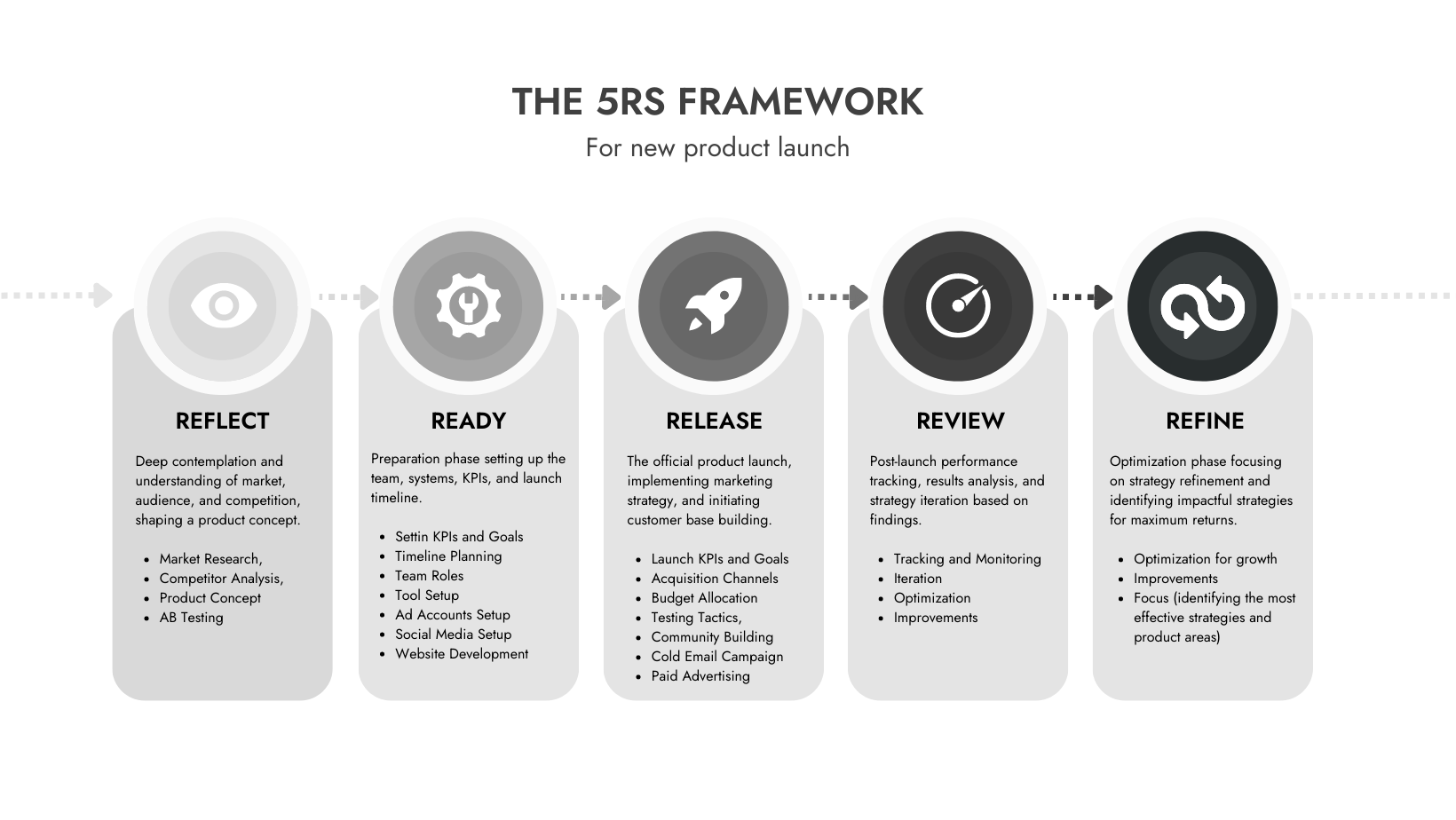
The five phases of the product launch journey
Through our experiments and testing tactics, we’ve identified five key stages that form the foundation of a successful product launch process. These stages are designed to guide you through the journey, ensuring that you cover all the critical aspects of a launch. We’ve crafted a comprehensive framework that encompasses these stages, allowing you to navigate the process with confidence and achieve results. By incorporating AI-powered tools and techniques into each stage, we’ll unleash the true potential of data-driven insights, giving you a competitive edge and propelling your product towards success.
Stage 1: Reflect (Pre-launch)
Market and Trends Analysis: By leveraging AI-powered tools, we will guide you in analyzing vast amounts of market data to identify emerging trends and unmet needs. With the help of prompts and GPT-based analysis, we can expedite these processes and extract valuable insights. This empowers us to tailor your product and strategies to captivate your target audience and gain a competitive edge.
Competitor Analysis: We will provide prompts and demonstrate leveraging AI models to gain comprehensive insights into your competitors’ strategies, strengths, and weaknesses. By utilizing GPT-based analysis, we can effectively differentiate your brand and secure a strong position in the market. These prompts and techniques will streamline the competitor analysis process, enabling you to make informed decisions and craft unique and effective strategies.
Analysis of Research Data: Using AI tools, specifically GPT-based analysis, we will show you how to process complex datasets and extract valuable insights that might be overlooked. By providing prompts and guiding you in utilizing GPT-based analysis, we can efficiently analyze research data to make informed, data-driven decisions that drive your product toward success.
Stage 2: Ready (Pre-launch)
Define KPIs and Goals: It is crucial to establish clear key performance indicators (KPIs) and goals right from the beginning. We will provide you with tools that will assist you in defining ambitious yet achievable targets, ensuring that your objectives are well-grounded and supported by insightful analysis.
Plan the Launch Timeline: A product launch roadmap plays a vital role in coordinating teams and ensuring the success of the launch. It allows team members to focus on high-priority tasks, make efficient decisions, and stay within scope. By setting realistic timelines for each milestone and assigning responsibilities to the appropriate team members, the product launch roadmap ensures efficient project management and a smooth launch process.
Assign Team Roles: Leveraging collaboration tools, we establish clear lines of communication and delegate responsibilities, fostering a collaborative environment where every team member shines. Together, we bring out the best in each other.
Set up Tools and Systems: By embracing digital tools, we streamline product development, project management, and marketing processes. This enhances efficiency, accuracy, and effectiveness, empowering us to navigate the pre-launch phase with confidence.
Stage 3: Release (Launch)
The Release stage is your moment in the spotlight. All the hard work done in the pre-launch phase comes alive here. We’ll show you how to use every available channel to announce your product. This could involve hosting a fun event, making an announcement on your website, sending out a special email, or getting influencers to share your product. The main goal here is to make a big impression and attract as many customers as possible.
Launch KPIs and Goals: Define measurable objectives and key performance indicators (KPIs) specific to your launch.
Identify Acquisition Channels: Discover effective channels for reaching your target customers, both organic and paid. Utilize prompts, ChatGPT, and other tools to accelerate the process of testing and discovering the best channels.
Budget Allocation: Strategically allocate your resources to optimize your reach and impact during the launch phase.
Testing Tactics: Experiment with different strategies to identify the most resonant approaches for your audience.
Community Building: Foster engagement and connections with your audience, nurturing a strong community around your product.
Cold Email Campaign: Create and execute a targeted cold email campaign to generate interest and attract potential customers.
Paid Advertising: Implement a paid advertising strategy that aligns with your target audience and objectives.
Stage 4: Review
The Review stage is dedicated to assessing the performance of your product post-launch. We meticulously analyze data and feedback to gain valuable insights for improvement. This is your chance to keep the momentum going and continue growing your customer base. We’ll guide you through strategies like improving your online visibility, running advertisements, keeping your customers engaged with your product and constantly improving your key values.
Performance Tracking: This phase involves carefully reviewing and monitoring the performance of each channel, analyzing their effectiveness and impact. By closely examining the data and feedback gathered, you can gain valuable insights to guide your decision-making process. Our focus will be on helping you optimize your channels, advertisements, and strategies based on the results obtained.
Optimization: By analyzing the results obtained during the Review stage, you will identify areas for improvement and make the necessary adjustments to enhance their performance. Through this iterative process, you will learn how to refine and fine-tune every aspect of your product launch to achieve even better results.
Stage 5: Refine
In the Refine stage, we will guide you in refining and perfecting everything that has been done so far. This is the phase where we take the insights gained from the Review stage and apply them to make iterative improvements.
Iteration: By leveraging the knowledge and feedback obtained, we will show you how to iterate and refine every aspect of your product, strategy, and implementation. This iterative approach ensures that you stay responsive to market dynamics, customer needs, and emerging trends. We will assist you in incorporating necessary adjustments, enhancements, and fine-tuning to maintain your offering’s relevance, competitiveness, and effectiveness.
The role of AI in product launch
In the exhilarating tech startup landscape, the introduction of the large language models like ChatGPT, Google’s Bard, and Microsoft’s Bing redefines the landscape of artificial intelligence. With their ability to generate human-like text, they’re revolutionizing business processes, making tasks like content creation, customer service, and coding significantly more efficient and productive. The introduction of the new feature- the plugins, marks a significant stride in the realm of Artificial Intelligence. Each plugin has its unique functionality and application, and some of them have emerged as particularly valuable in the context of product launch.
The possibilities with AI today are limitless. Our program will give you useful insights how to use AI tools in every part of the product launch process, such as: de-risking and self- audit, market analysis and trend analysis, competitor analysis, research data analysis, spotting acquisition channels and strategies, content writing, social media posting and ad copies.
By utilizing AI models, you can analyze a wealth of information (market data, acquisition channels, competitive landscape); process and interpret complex datasets, identify potential opportunities, and generate a wide range of content.

Leson 1
Self- assessment
The first crucial step before diving into product launch is to understand your current growth stage clearly. There are 5 key stages of business growth:
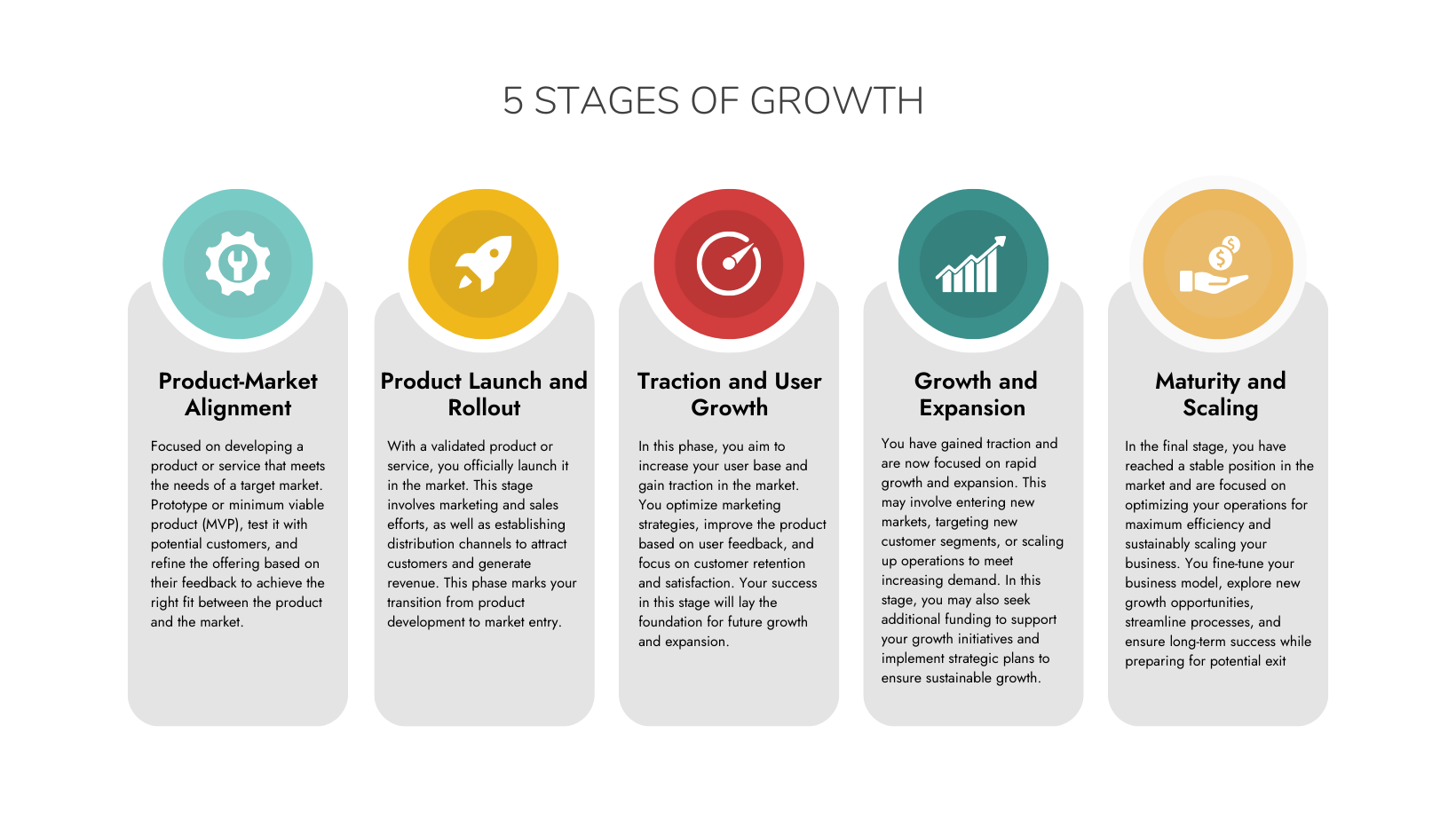
How to define your company’s current stage of growth?
Follow the simple 3-step process in order to identify your current growth stage:
- Assess your product development and market alignment
- Evaluate your market presence and customer base
- Analyze your growth strategy and operational efficiency
The best way to perform assessment of your current state and to learn where you stand is to do it by yourself, following our guidance bellow.
Here’s how we do it:
1. Pop open the TOOL FOR SELF-EVALUATION. Make a copy of it.
2. Initially, start by answering the provided questions with Yes/ No.
3. Then continue by filling in the rest of the template to understand your
current stage of growth
By following these steps, you will understand where you need to focus primarily and what the future action steps should be. If you need extra help for performing self-assessment and evaluation, AI tools would be the right choice.
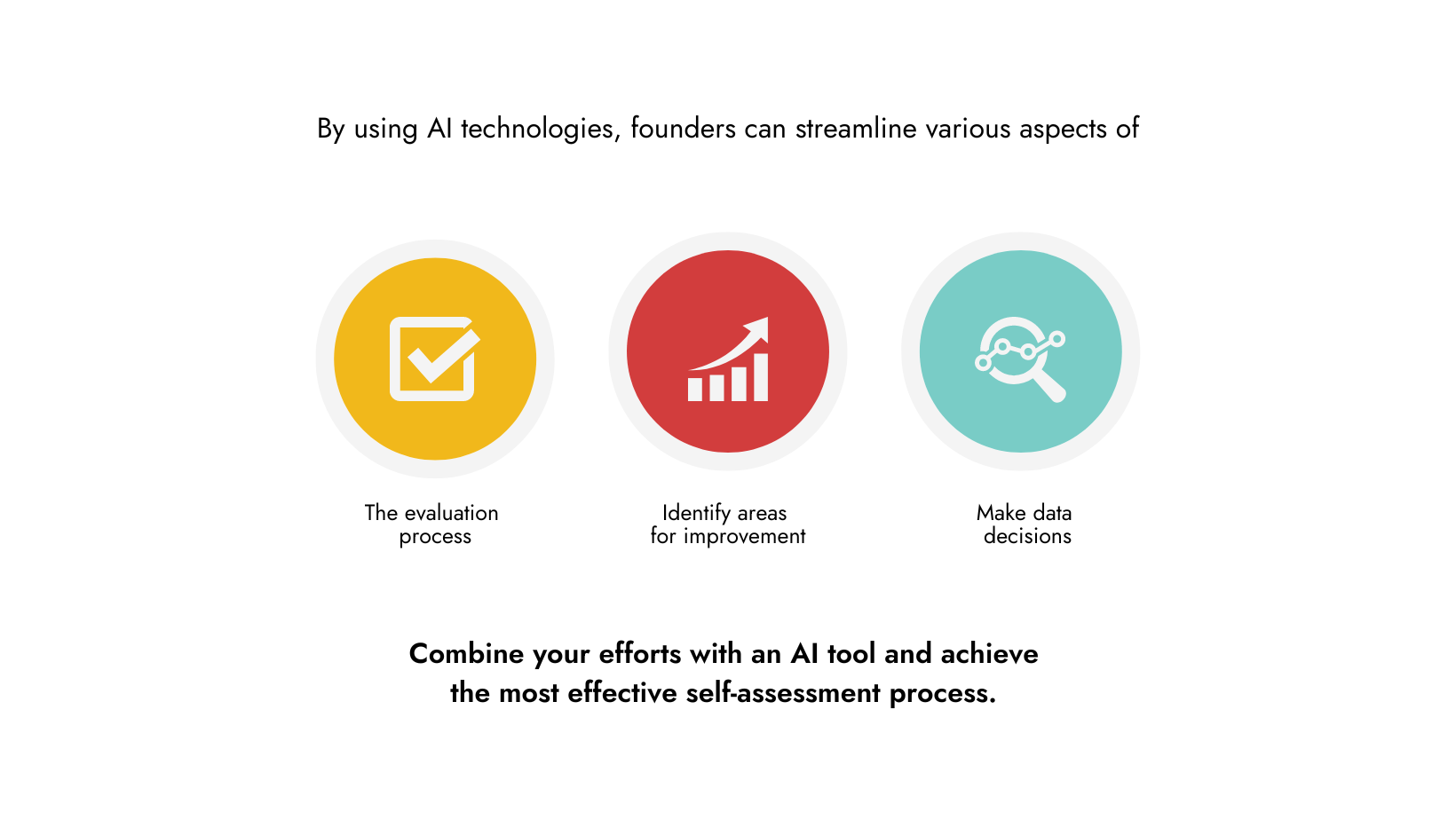
Here are few examples on how to use AI tools for self-assessment:
User feedback analysis:
AI-powered sentiment analysis tools can process vast amounts of user feedback from app stores, social media, and support tickets.
Market analysis:
AI tools can help identify market trends and competitor performance, helping founders identify gaps in the market and differentiate their products from competitors.
Predictive analytics:
Tools like DataRobot can analyze historical data and user behavior patterns to predict future trends.
A/B testing and optimization:
AI-powered tools like Optimizely can help startups conduct A/B testing more efficiently.
Personalization and recommendation:
AI technologies can create personalized recommendations based on user behavior and preferences.
Competitor analysis:
AI can help startups gain insights into competitors’ strategies, strengths, and weaknesses.
Product analysis:
AI-powered analytics tools can help founders analyze user interactions with their product, providing insights into feature usage, bottlenecks, and conversion rates.
Product Launch Prep:
Building Desirable Products
Here are two examples out of top 10 research methodologies powered by AI covered in this program:
Market Research
Gather and analyze data on market size, growth trends, and potential customer segments to understand the market landscape and identify opportunities for your product.
Competitor Analysis
Research your competitors’ products, strategies, strengths, and weaknesses to determine how you can differentiate your product and gain a competitive advantage.
Other research methodologies that we cover in the program:
Customer interviews
Surveys and Questionnaires
A/B testing
Focus Groups
Usability
Testing
Observational Research
Ethnographic Research
SWOT Analysis
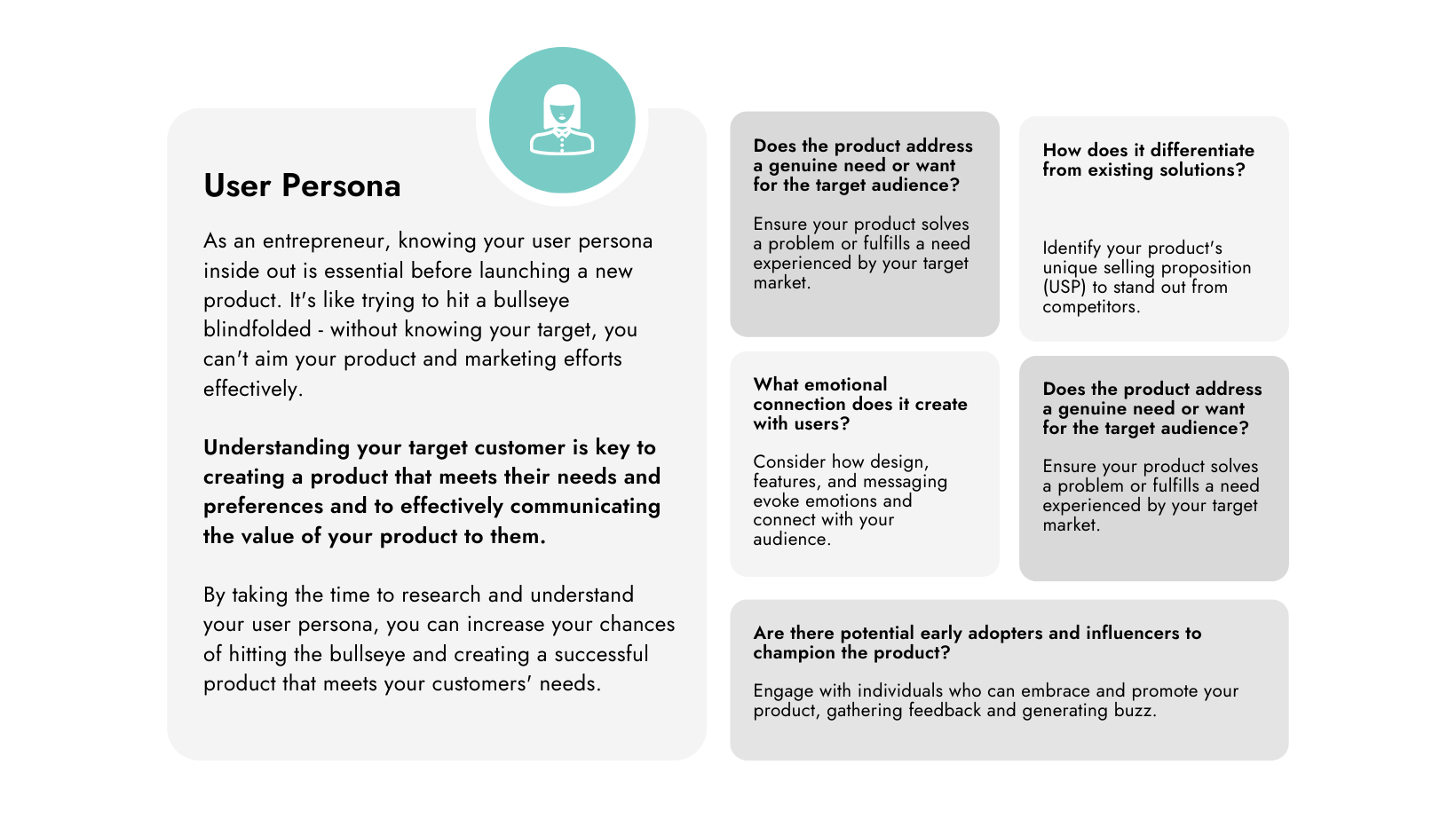
RESEARCH emerging trends with AI
The advent of AI has revolutionized the way businesses identify and capitalize one merging trends, transforming the process into a data-driven and efficient endeavor. By harnessing the power of AI-powered tools, organizations can delve into vast amounts of data from diverse sources, such as social media, news articles, and market reports, to uncover patterns and insights that signify new market trends. This invaluable intelligence enables businesses to stay ahead of the curve, identifying opportunities and potential challenges before they become mainstream. Here is an example how to gather insights with ChatGPT:

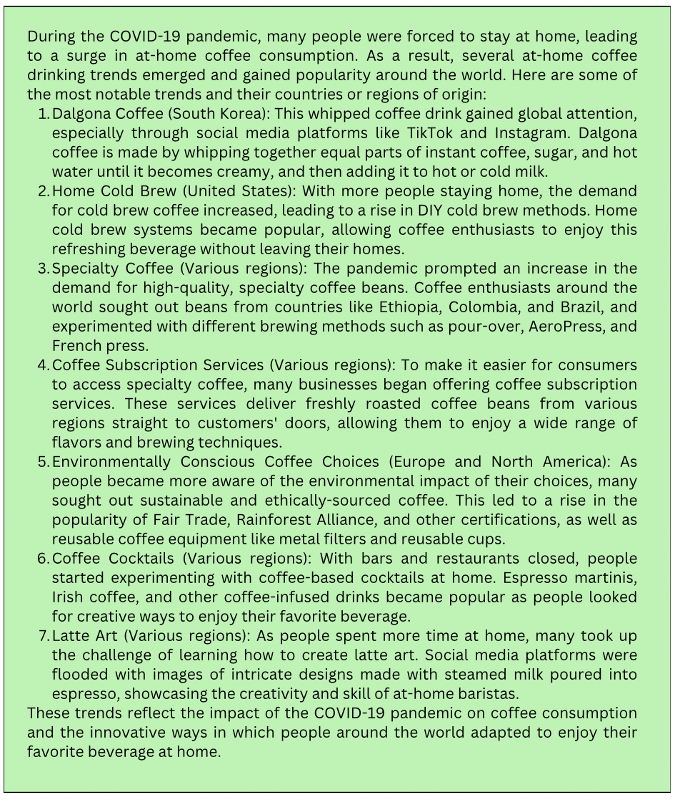
Lesson 3
Project Management:
Tools and Tactics
Leveraging tools in the process of launching a product can be highly beneficial for entrepreneurs for several reasons: improve efficiency, enhanced organization, improved decision-making, cost-effectiveness, increased productivity, better customer engagement, scalability, greater competitiveness, high-quality products, professionalism.
Our program offers you an extended list of suggested project management tools that can increase your team’s productivity and efficiency. Some of them include Asana, Trello, Notion, Slack, HubSpot CRM, Google Drive and many more.
Whether you are an experienced entrepreneur or embarking on your first product launch, this part of the program provides insights and practical strategies to optimize your project management approach. By using the right tools and employing proven tactics, you can effectively navigate the product launch process, facilitate team work and ensure timely delivery.
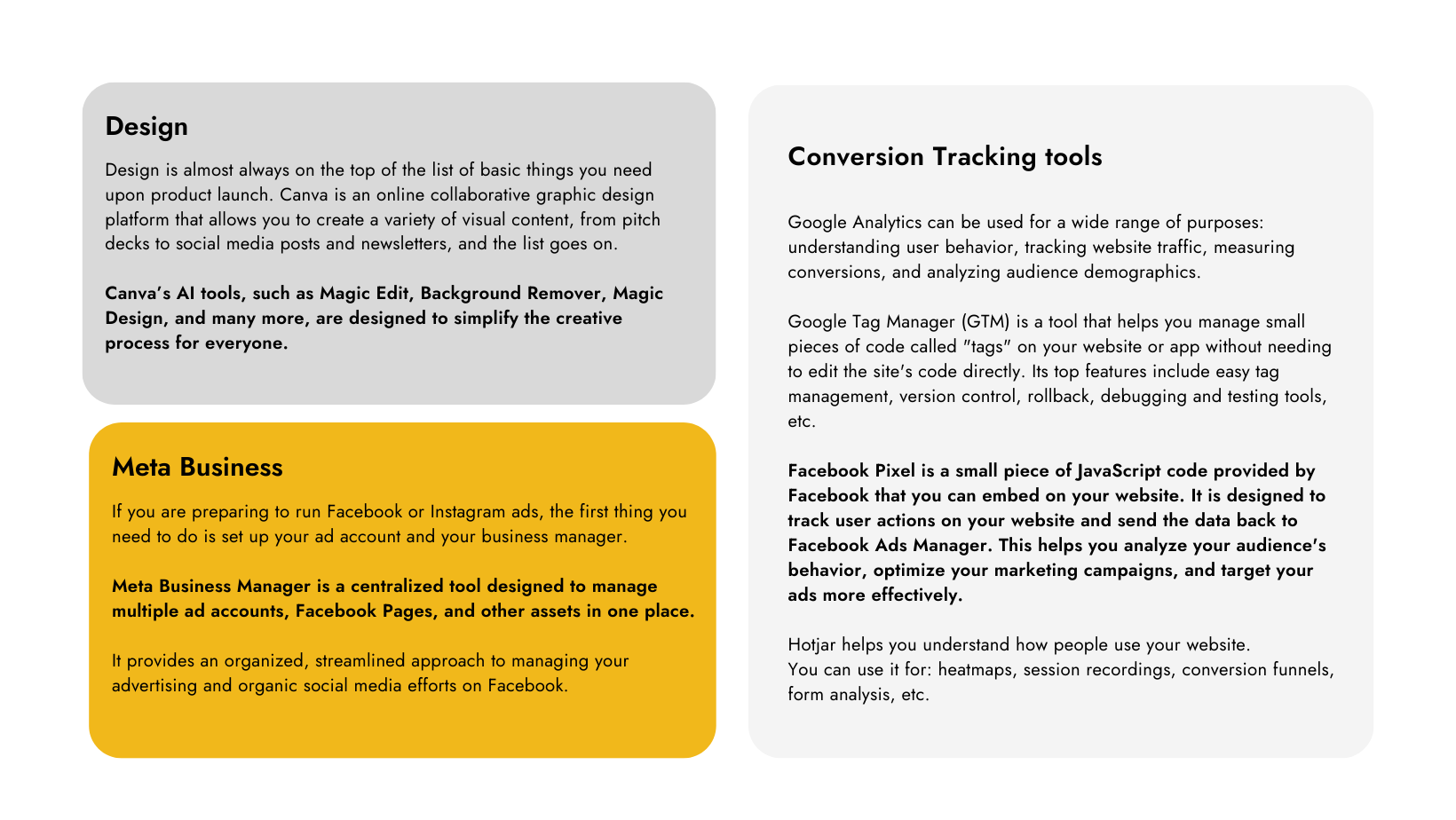
Lesson 4
Developing a winning acquisition
strategy
An acquisition strategy in product launch refers to the plan and tactics implemented by a company to acquire new customers and users for their newly launched product or service. It focuses on attracting and converting potential customers into paying customers, thereby driving sales and revenue growth.
The acquisition strategy is a vital component of a product launch as it determines how the target market will be reached, engaged, and persuaded to try and adopt the new offering. It involves a combination of marketing channels, techniques, and campaigns designed to generate awareness, interest, and demand among the target audience.
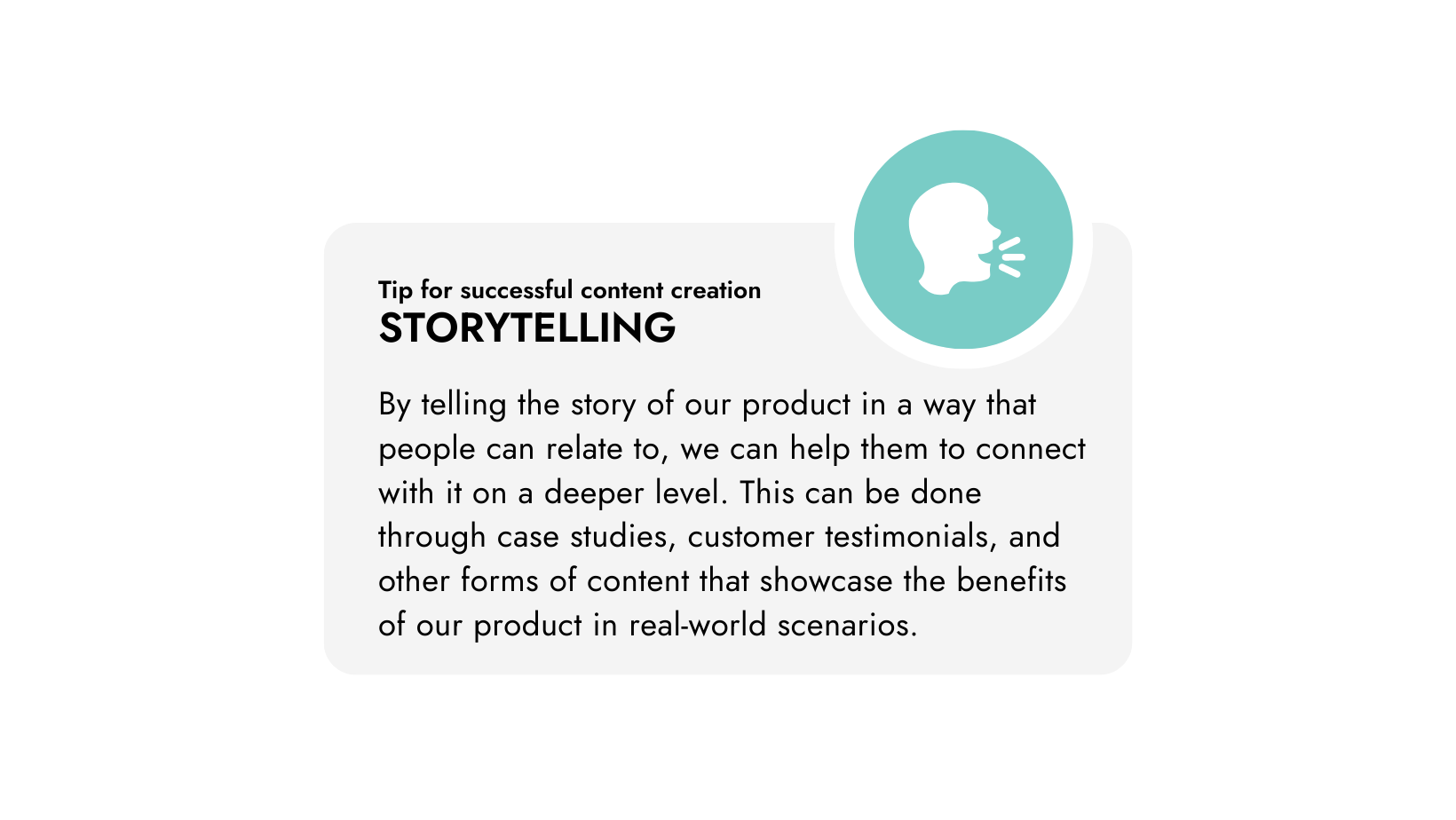
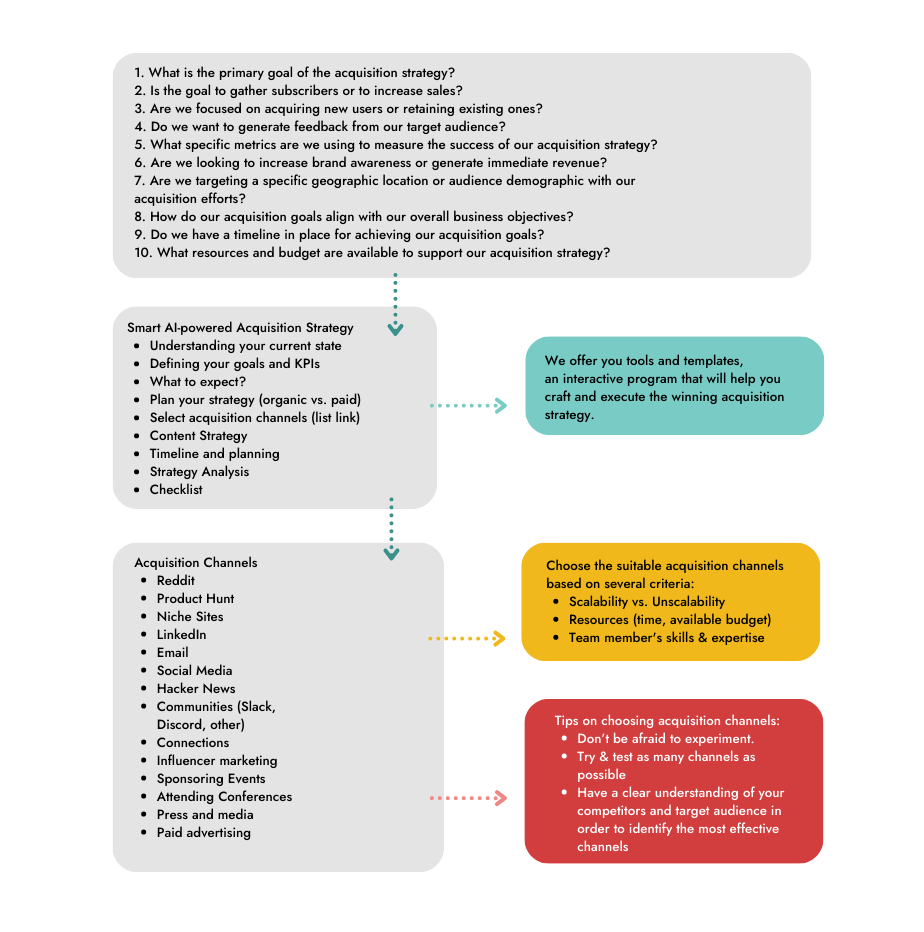
Lesson 5
Mastering acquisition channels
Unpaid acquisition strategies focus on creating valuable content, building brand reputation, and fostering organic growth over time. While it may take longer to see results compared to paid acquisition, it can result in loyal customers, brand advocacy, and sustainable business growth. From what we have seen so far, most startup founders launch only via organic channels as a first step. This will help them:
➡️ Test the product before actually spending too much on it
➡️ Pivot or improve using early feedback
➡️ Get some awareness and actually build a name around the brand early and organically
➡️ Test many different audiences, and find the right one
➡️ Lower the burn rate
Our program offers an extended review of all organic and paid acquisition channels that one startup needs. Bellow you can find only three examples of organic channels: content marketing, building communities and cold email outreach.
Content Marketing
In today’s world, the success of any business is heavily dependent on the quality and relevance of its content.
“Content is king.”- Bill Gates
By creating compelling and informative content, you can attract and engage their target audience, build brand awareness, and achieve their marketing goals. Whether it’s through informative blog posts, visually appealing infographics, or engaging social media updates, good content is essential for establishing a strong online presence and standing out in a crowded digital landscape.
AI has revolutionized the way we generate new content by providing powerful tools and algorithms that enable us to create, optimize, and distribute content more efficiently and effectively than ever before. AI has transformed content creation is through content generation, where AI-powered tools like ChatGPT-3 can create new content based on specific inputs and parameters.
AI can help you with content creation in several ways:
Content creation: AI-powered tools like GPT-3 can generate new content based on a set of parameters and inputs. For example, a news website may use AI-generated content to produce breaking news stories quickly, or an e-commerce website may use AI to generate product descriptions for thousands of products.
Personalization: AI can analyze user data and behavior to create personalized content that is tailored to everyone’s interests and preferences. For example, a music streaming service may use AI to create custom playlists based on a user’s listening history, or a retailer may use AI to suggest products based on a customer’s purchase history.
Optimization: AI-powered tools can analyze content performance data to identify patterns and optimize content for better results. For example, a blog may use AI to identify the best keywords to include in a blog post to improve its search engine rankings, or a social media manager may use AI to analyze engagement metrics to determine the best times to post content.
Translation: AI-powered translation tools can quickly and accurately translate content into multiple languages, making it easier to reach a global audience. For example, a travel website may use AI to translate their website into multiple languages to attract more international visitors.
Editing: AI-powered editing tools can help to improve the quality of content by identifying errors in spelling, grammar, and punctuation. For example, a writer may use an AI-powered grammar checker to improve the accuracy and readability of their writing.
Tip for content repurpose with AI in less than 5 minutes:
Imagine you are writing a blog post that you will also need to distribute later.
By using ChatGPT you can easily add the full text inside and say:
‘ Make it into a tweet.’
Or‘
Make5 posts for LinkedIn from this text.’
Simple as that.
And you not only have a blog post ready, but a full distribution plan with ready copies for posting and sharing.
Bellow you can find the prompts for content creation and content repurposing:
Build and engage a community for your product launch
Building a community around a product launch involves cultivating a network of engaged users, customers, and advocates who are passionate about the product and actively participate in discussions, feedback, and promotion.
The purpose of fostering a community during a product launch is to create a sense of belonging, loyalty, and support among its members. It provides a platform for users to connect with each other, share experiences, provide feedback, and contribute to the growth and improvement of the product.
Communities (although not all) have remained the most valuable and reliable source of information. However, as communities have become highly appreciated, we see many, if not majority of, communities being used for promotional purposes and therefore lose their purpose and become very vague and unengaged. If you really want to take full advantage of a community, building your own would be the right approach. Once you create your own community, how to keep it engaged?
Here are useful tips how to engage your community members:
1.Start from your perspective. Finding a role model is the easiest way to set the framework for your upcoming community. Make a list of the qualities of a community you are a part of that you like or dislike. After all, it is YOUR community. Consequently, it should reflect your ideals. Ask yourself these questions:
What keeps me returning to this community?
What made me feel special?
What is something I would change?
2.Create valuable and engaging content. Deliver what you’ve promised your members. Try to provide new and exciting content consistently. Offer resources such as guides, tutorials, or other materials to help members learn and grow and provide support when needed.
3.Encourage interaction. Provide opportunities for members to connect with one another and share their thoughts and ideas. Facilitate engagement by starting discussions, answering their questions, and creating polls.
4.User-generated content. The most powerful incentive for people to engage in encouraging your audience to share their experiences. Referring to companies fosters a stronger connection between members, who bond over reviews, shared ideas, and, most importantly, mutual support.
5.Increase responsiveness. Conversation is a two-way street, so try to respond to any comment or question, ensuring the members are heard. If the topic isn’t in your domain, try to find a member who knows the answer or is more knowledgeable in the area.
6.Reward regular contributors. Show appreciation for members who actively participate in the community by recognizing their contributions. Reward constructive comments, which can be positive or negative, but the result is almost always positive. These statements might seem harsh to the person receiving the comment, but they bring significant value to the community by conducting objectivity.
7.Involve members in the growth process. Be transparent and communicate about the future plans for your community. Practice co-creation, listen to your members’ opinions, and allow them to participate in decision-making.
8.Organize events. As your community grows, you will attract more experienced people who are already popular among your members. Utilize these authentic connections and organize events such as AMAs, interviews, podcasts, and webinars. This is a fantastic way to boost your community and give its members a sense of exclusivity.
9.Delegate your responsibilities among colleagues. Even though there might be a few people in your company, assigning several tasks to each of you will make managing easier. Their involvement in the community will provoke others to activate, portraying a safe and dynamic environment.
10.Gamification. Leveraging the competitiveness of your members keeps them engaged. You can choose a reward system based on the options available for your community’s preferred platform. For more information on choosing the ideal platform for your needs, see our earlier blog post on building an online community. By offering badges and titles to contributors, members may feel more incentivized to stay active and post content.
By implementing these tips and listening to the needs of your community, you can keep your community engaged and foster a sense of belonging and aspire support among members.
Intelligent Cold Email Outreach
Cold outreach is ‘free’; it requires much attention to detail and daily monitoring of results. By leveraging cold outreach, you can achieve multiple objectives, such as acquiring new customers, securing funding, establishing partnerships, and gaining valuable insights from industry experts.
Needless to say, we are being spammed every day with tons of cold emails, so you really need to know how to stand out and make it worth your while.
Cold outreach tools:
1. Mailshake: a user-friendly email outreach tool that offers features like email templates, personalization, campaign scheduling, A/B testing, and follow-up automation. It also provides analytics for tracking campaign performance and integrates with popular CRM platforms.
- Lemlist: a popular cold email outreach tool that allows you to create personalized email campaigns using dynamic images, videos, and custom variables. It offers features such as automatic follow-ups, A/B testing, and in-depth analytics. Lemlist also integrates with various CRM systems and sales tools.
- Apollo.io: a comprehensive sales engagement platform that combines email outreach, phone calls, and CRM data to help you target the right prospects. It offers advanced personalization, automated follow-ups, and detailed analytics. Apollo.io also provides access to a database of millions of verified B2B contacts.
- Woodpecker: a cold email outreach tool designed specifically for B2B sales teams. It offers features like email personalization, automated follow-ups, and campaign scheduling. Woodpecker also provides analytics for tracking email performance and integrates with popular CRM platforms.
- Reply.io: a multi channel sales engagement platform that supports cold email outreach, as well as LinkedIn and phone-based campaigns. It offers email personalization, automated follow-ups, and A/B testing. Reply.io provides analytics to track campaign performance and integrates with various CRM systems and sales tools.
Tip for cold outreach:
Cold emailing is not a one-shot opportunity but rather a funneled approach and sequence with a set of steps and approaches aiming to trigger some kind of engagement from the receiver. In order to automate the process and avoid manually checking and monitoring each KPI, outreach tools allow you to create funnels and automated sequences.
Typically an outreach funnel consists of 3 emails sent over a period of time. Depending on the contents of the email, the funnels usually go:
1st email
Wait three days
2nd email
Wait seven days
3rd email
AI can significantly improve your outreach messages, or it can write an impressive one from scratch.
Lesson 6
Paid Acquisition
Paid acquisition involves spending money on various marketing channels and tactics to attract and acquire customers. It typically involves advertising campaign sand activities where businesses pay for exposure, visibility, and user engagement. Paid acquisition provides businesses with more control over targeting specific audiences, increasing brand visibility, and driving immediate results. However, it requires careful planning, monitoring, and optimization to ensure a positive return on investment (ROI).If you are in an early stage with your product, and if it is still in development and not launched, paid acquisition will most likely be your second stage of user acquisition. You can always use paid channels as an approach for some early testing, but make sure you know what you want to discover, have a clear goal and test efficiently.
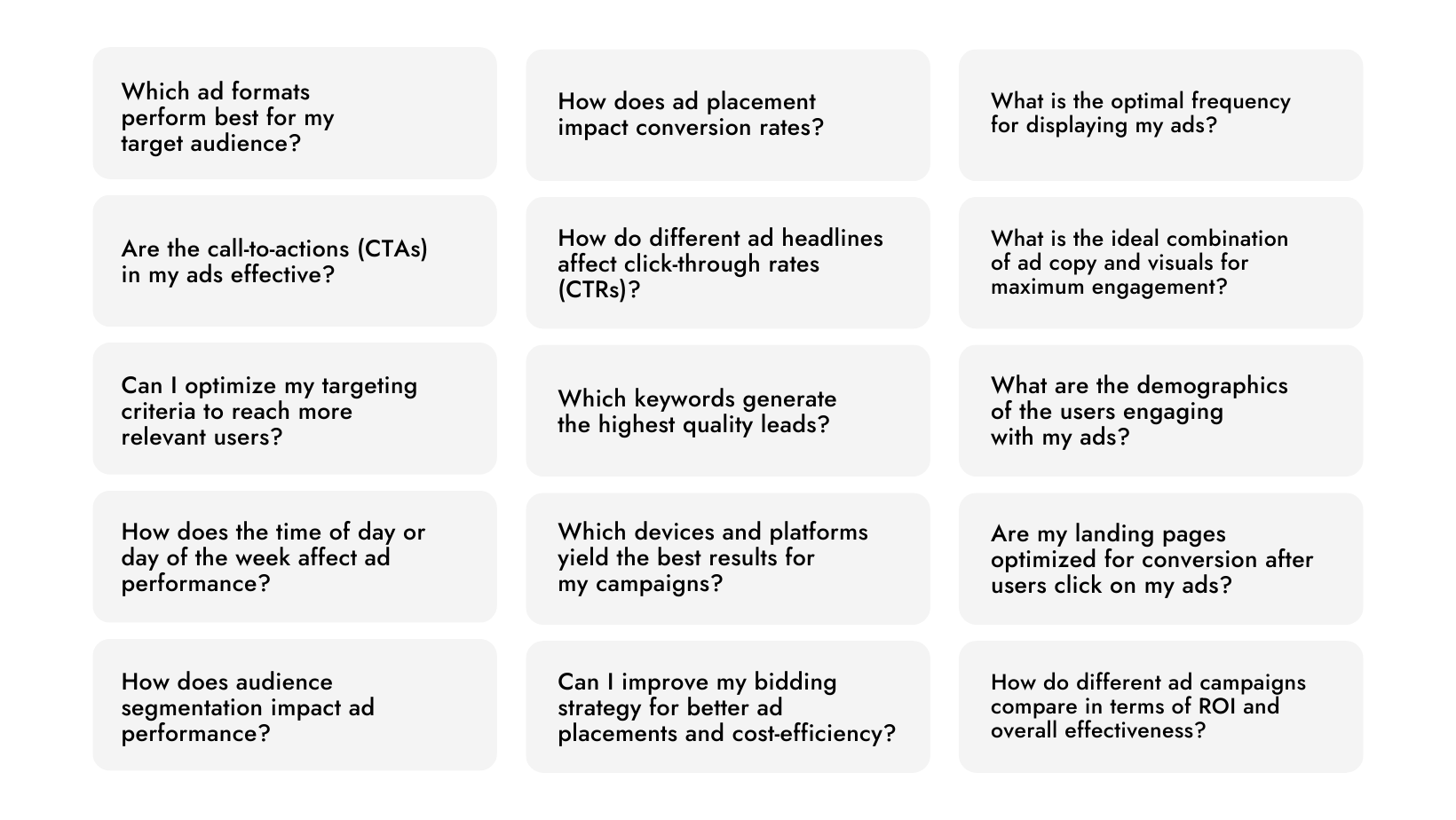
Tips for successful paid acquisition strategy
Plan your budget properly. Allocate a suitable budget for paid acquisition, considering marketing objectives, expected ROI and overall financial health of the startup. Set clear expectations, goals and KPIs.
Choosing the right paid acquisition channels for your startup involves careful consideration and strategic planning. The pool for paid advertising is quite deep. Here is a list of channels you can choose from:
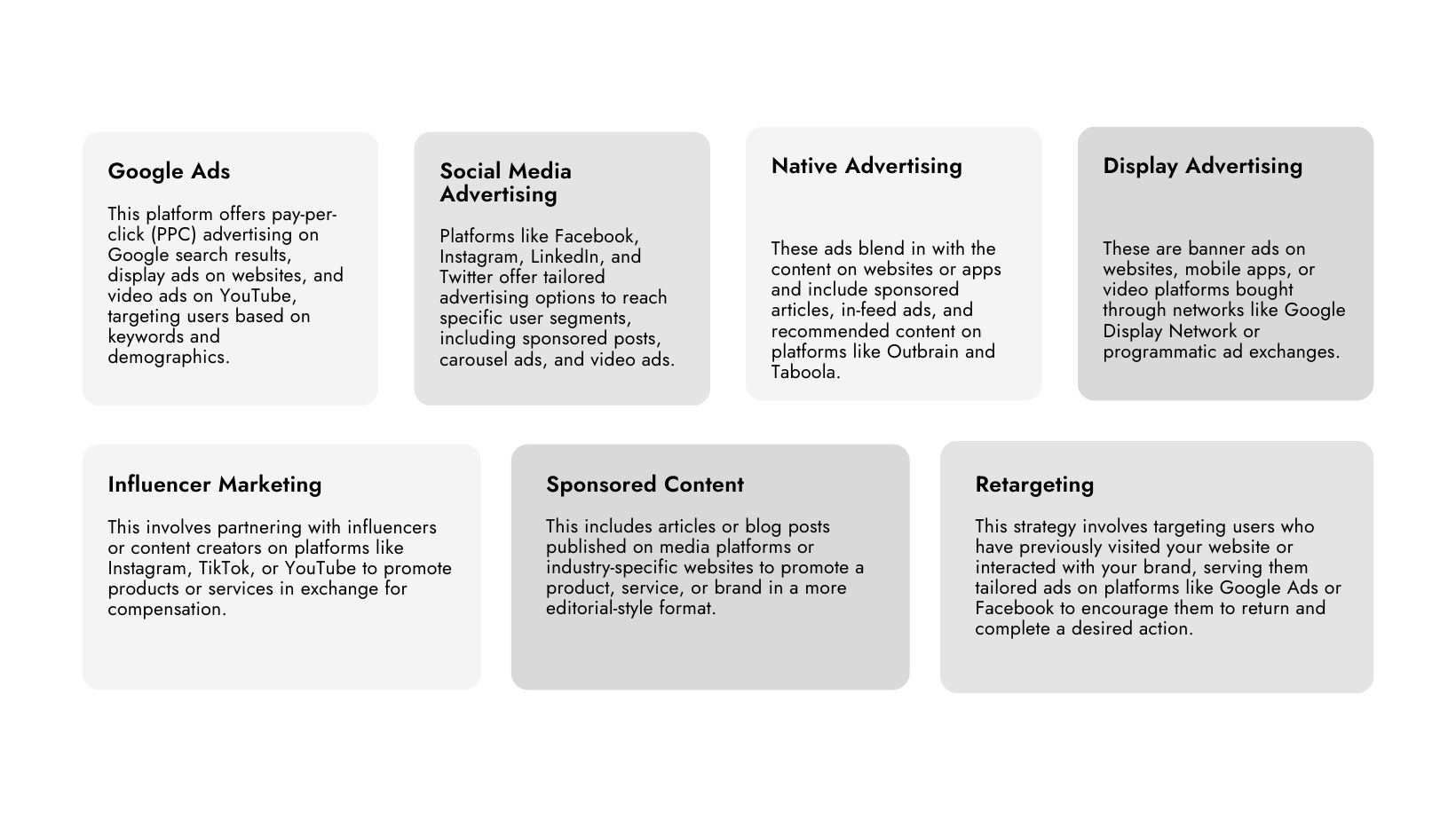
Let’s take Google ads as an example. As you open Google, most probably, your searches would be:
➡️ Best tactics for launching a startup
➡️ Best performing acquisition channels for a product launch,
➡️ How to get traction,etc.
As an agency offering services and courses in this domain, we take a customer-centric approach to understand what potential customers like you would search for. We analyze the relevant keywords such as “launching a startup,” “acquisition channels,” “product launch,” and “getting traction”, knowing that this is something you might search for.
This would be a real win-win as you are searching for a service or program like this, and we are the ones providing it. AI can be a powerful help in your ad campaigns regarding keyword research and copywriting.
AI-powered keyword research and copywriting
AI-powered keyword research tools use advanced algorithms and machine learning to help you discover the most effective keywords for your content and ad campaigns. These tools can streamline the keyword research process, providing insights that can improve your search ad performance.
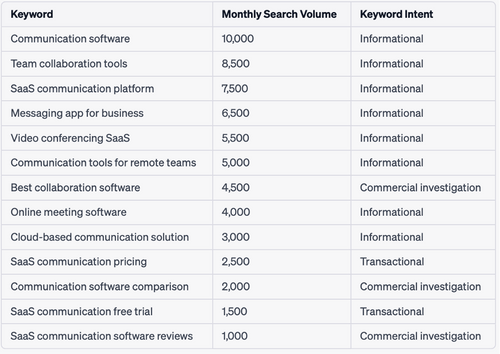
Search ads are not easy to write, as you are limited in the number of characters, and you have a specific structure. You only have a few words to describe your product, your offering, your price or promotion, your value proposition, and to address your audience.
You are probably aware that the less words you have, the more difficult it is to say. Thanks to Generative AI, you will now be able to write extremely powerful copies in seconds. Keep in mind that in order to get a good copy, you need the best prompt. Otherwise, you will just get a generic copy.
Open a new chat and tell GPT all the details about your product. Insert your keywords, explain your campaign goals, and wait for the magic to happen. In case you are not sure about the first draft, don’t worry; the options are limitless. You can generate as many copies as you need. Just make sure to ask for the right thing and point in the right direction.
Here are PROMPTS Templates that you can use for your ad campaigns.

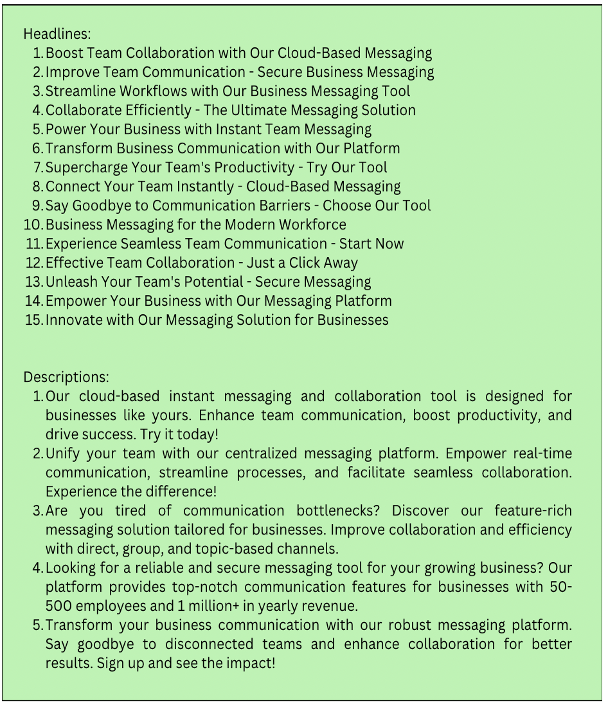
Our program offers comprehensive and guided lessons for every paid acquisition channel, with a specific focus on:
➡️ Google Ads
➡️ Facebook and Instagram Ads
➡️ LinkedIn Ads
➡️ AI powered tools for paid acquisition channels.
The selection of paid acquisition channels may evolve over time as you gather more data, refine your targeting, and learn about your audience’s preferences. We can recommend to always stay agile and adapt your strategy based on insights and feedback to optimize your marketing efforts effectively.
Lesson 7
Post-launch optimization for growth
The post-launch phase for a product refers to the period after the product has been introduced to the market. It is a critical stage where companies focus on activities aimed at maximizing the product’s success and achieving long-term growth. Here are some key aspects of the post-launch phase:
Track performance
Assess the product’s performance based on predefined key performance indicators (KPIs) and metrics. Analyze sales data, customer feedback, and market response to understand how well the product is meeting expectations and identify areas for improvement.
Monitor Competitors
Keep a close eye on competitors and their activities. Monitor their product offerings, pricing, marketing campaigns, and customer feedback. Identify opportunities to differentiate your product and stay ahead in the market.
Product Updates and Iterations
Continuously improve and enhance the product based on customer feedback, market trends, and technological advancements. Release regular updates, new features, and enhancements to meet evolving customer needs and maintain a competitive edge.
Continuous Improvement
Adopt a mindset of continuous improvement. Regularly review and refine your strategies, processes, and offerings to ensure that your product remains relevant and competitive in the market.
Lesson 1
Lesson 2
Product Launch Prep:
Building Desirable
Products
Lesson 3
Project Management:
Tools and Tactics
Lesson 4
Developing a
winning acquisition
strategy
Lesson 5
Mastering Acquisition
Channels
Lesson 6
Lesson 7
